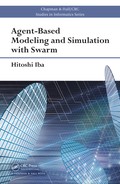References 283
[101] Reynolds, C.W.: “Flocks, herds and schools: a dis-
tributed behavioral model,” Computer Graphics,
vol. 21, no.4, pp. 25–34, 1987.
[102] Rucker, R.: Artificial Life Lab, Waite Group Press,
Bolinas, CA, 1993.
[103] Sandel, M.: Ju s tice: What’s the Right Thing to Do?
Penguin, London, 2010.
[104] Sayama, H.: “Swarm chemistry,” Artificial Life,
vol. 15, no.1, pp. 105–114, 2009.
[105] Schelling, T.C.: “Dynamic models of segregation,”
Journal of Mathematical Sociology, vol. 1., pp. 143–
186, 197 1.
[106] Sims, K.: “Artificial evolution for co mputer graph-
ics,” ACM Computer Graphics, vol. 25, no.4,
pp. 319–328, 1991.
[107] Sims, K.: “Evolving virtual creatures ,” Proceedings
of Computer Graphics (SIGGRAPH’94), pp. 15–22,
1994.
[108] Sims, K.: “Evolving 3D morphology and behavior
by competition,” Proceedings of Artificial Life IV,
Brooks,R. & Maes,P. (eds.), pp. 28–39, MIT Press,
Cambridge, MA, 1994.
[109] Sims, K.: Galápagos, http://www.genarts.com/
galapagos/
http://www.ntticc.or.jp/, 1997.
[110] Suganthan, P.N., Hansen, N., Liang, J.J., Deb, K.,
Chen, Y.P., Auger, A., and Tiwari, S.: “Problem
definitions and evaluation cr iteria for the CEC 2005
Special Session on Real-Parameter Optimization,”
Technical Report, Nanyang Technological Univer-
sity, Singapo re, May, 2005.
[111] Tabor, J.J., Salis, H.M., Simpson, Z.B., Chevalier,
A.A., Levskaya, A., Marcotte, E.M., Voigt, C.A.,
and Ellington, AD.: “A synthetic genetic edge. de-
tection program,” Cell, vol. 137, no.7, pp. 1272–
1281, 2009.
284 References
[112] Takeuchi, Y., Iwasa, Y., and Sato , K.: Mathematics
for Ecology And Environmental Sciences ( Biologi-
cal and Medical Physics, Biomedical Engineering),
Springer-Verlag, Berlin, Germany, 2007.
[113] Takashima, A., Minegishi, R., Kurabayashi, D., and
Kanzaki, R.: “Construction of a brain-machine hy-
brid system to analyze adaptive behavior of silk-
worm moth,” Proceedings of 2010 IEEE/RSJ Inter-
national Conference on Intelligent Robots and Sys-
tems (IROS2010), pp. 2389–2394, 2 010.
[114] Teller, A. and Veloso, M.: “PADO: Learning tree
structured algorithms for orchestration into an ob-
ject recognition system,” Technical Report CMU-
CS-95-1 01, Pittsburgh, PA, USA, 1995.
[115] Takagi, H. and Ohsaki, M.: “IEC-based hearing aids
fitting,” Proceedings of the IEEE International Con-
ference on Systems, Man, and Cybernetics (IEEE
SMC99), pp. 12–15, 1999.
[116] Takagi, H. and Iba, H.: “Interactive evolution-
ary computation,” (specia l issue) New Generation
Computing, vol. 23, no.1, pp. 113–114, 2005.
[117] Tohge, T. and Iba, H.: “Evolutionary morphology
for polycube robots,” International Journal of Ad-
vanced Robotic Systems, Frontiers in Evolutionary
Robotics, pp. 567–586, 20 08.
[118] Tohge, T. and Iba, H.: “Evolutionary morphol-
ogy for cubic modular robot,” Proceedings of 2006
IEEE World Congress on Computational Intelli-
gence (CEC2006), pp. 1995–2001, 2008.
[119] Torrance , S.B.: The Mind and the Machine: Philo-
sophical Aspects of Artificial Intelligence, Ellis Hor-
wood, Harlow, UK, 1984.
[120] Tokui, N. and Iba, H.: “Music c omposition with in-
teractive evolutionary computation,” Proceedings of
the 3rd Annual International Conference on Gener-
ative Art, Milan, Italy, 2000.
[121] Unemi, T.: “SBART2.4: Breeding 2D CG images
and movies, and creating a type of collage,” Pro-
ceedings of t he Third International Conference on
References 285
Knowledge-Based Intelligent Information Engineer-
ing Systems, pp. 288–291. 1999.
[122] Wakaki, H. and Iba, H.: “Motion design of a 3d-cg
avatar using interactive evolutionary computation,”
Proceedings of 2002 IEEE International Conference
on Systems, Man and Cybernetics (SMC02), IEEE
Press, 2002.
[123] Wallace, A.R.: Darwinism: An Exposition of the
Theory of Natural Selection, with Some of its Ap-
plications, Macmillan, New York, 1889.
[124] Werner, G.M.: “Why the peacock’s tail is so short,
limits to sexual selection,” in Artificial Life V, Lang-
ton, C.G. and Shimohara, K.(eds.) pp. 85–91, MIT
Press, Cambridge, MA, 1996.
[125] Werner, G.M. and Todd, P.M.: “Too many love
songs: Sexual selection and the evolution of commu-
nication,” Proceedings of the Fourth European Con-
ference on Artificial Life (ECAL97), pp. 434–443,
MIT Press, Cambridge, MA,1 997.
[126] Wilson, E.O.: S ociobiology: The new synthesis,
Belknap Press, C ambridge, MA, 197 5.
[127] Wilkinson, G. S. “Reciprocal food sharing in the
vampire bat,” Nature 308: 181–184.
[128] Wolfram, S.: A New Kind of Science, Wolfram Me-
dia, Champaign, IL, 2002.
[129] Yamaguchi, M., Yoshimoto, E., and Kondo, S.:
“Pattern regulation in the stripe of zebrafish sug-
gests an underlying dynamic and autonomous
mechanism,” Proceedings of the National Academy
of Sciences, vol. 104, no. 12, pp. 4790–4793, 2007.
[130] Zahavi, A. and Zahavi, A.: The H andicap Principle:
A Missing Piece of Darwin’s Puzzle, Oxford Univer-
sity Press, Oxford, UK, 1999.
This page intentionally left blankThis page intentionally left blank

FIGURE 4.9: Sexual selection in a two-dimensional space.
..................Content has been hidden....................
You can't read the all page of ebook, please click here login for view all page.
